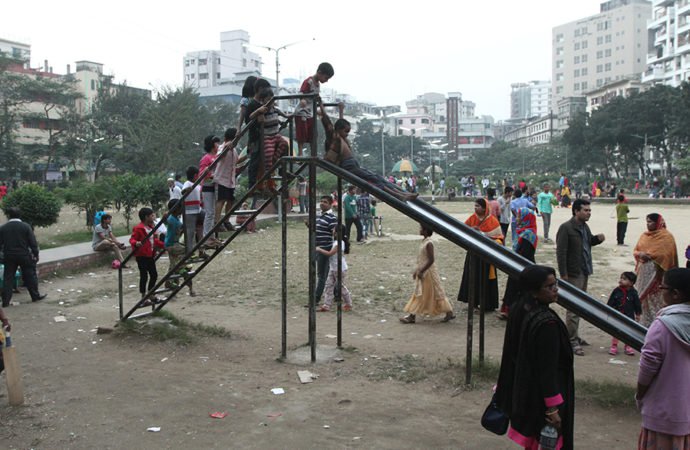The lifeblood of every city are its open spaces that allow residents to breathe fresh air. The Dhaka Tribune has embarked on a journey to explore the state of parks and playgrounds all over Dhaka in an eight-part series to uncover how sustainable our city is. In the fourth part of the series, we ask people from Mirpur and Mohammadpur how they feel about the lack of open spaces.
Residents of greater Mirpur and Mohammadpur are amongst many others in Dhaka who do not have access to enough playgrounds and parks for recreational and cultural activities.
The streets are filled with people going for a run in the early hours of the morning. Televisions and computers have replaced recreational activities, which in the past was something healthier.
At least five constituencies cover Mirpur and Mohammadpur, with five members of parliaments (MPs), 20 male and six female councillors. Residents have complained their representatives have done nothing to address this issue.
Also Read- Who will save the parks of Dhaka?
According to Tarekuzzaman Rajib, commissioner for DNCC Ward no 33: “There is inadequate space in Katasur-Chan Mia Housing area. We are striving to make the most of whatever space we have.”
As per a 2011 census of the Bangladesh Bureau of Statistics, a total of 2,327,850 people live in the area with 396,182 living in Kafrul, 596,835 in Pallabi, 500,373 in Mirpur, 115,489 in Shah Ali, 159,139 in Darus Salam, 203,989 in Adabor and 355,843 in Mohammadpur.
But residents from these places say the numbers have already exceeded 3,000,000.
The parks are mostly found near residential areas. While it is understandable for densely populated areas to not have parks, not having one in an entire ward makes a mockery of urban planning, say experts.
Also Read- No playgrounds for Old Dhaka
Although there are a total of 14 parks and 20 fields in the areas, they remain off-limits to most people due to authorities repurposing them for various reasons.
In Mohammadpur, children love to play football and cricket. Most of them are forced to concurrently share the three fields in the area.
In the past, people would go to the Mohammadpur Eidgah field. But in 2016, the field was closed off to the public. Currently, the field is only open to sports programs authorized by schools.
Chandrima Udyan, the only open spot of fresh air for Mohammadpur residents Mahmud Hossain Opu/Dhaka Tribune
Badshah Miah from Katasur said: “We do not have any fields nearby. Our children have to go far to play football or cricket. That is probably why they prefer watching TV or being on social media all the time. I feel my children are become addicted to Facebook and such sites.”
Also Read- Dhaka’s parks: In the heart of Dhanmondi
Shakil Ahmed from Mohammadpur chimed in: “There are too many of us at once on a field and there is hardly any space to enjoy ourselves. It is a lot easier to play video games on my phone or computer.”
The lack of facilities sends a great many Mohammadpur residents to Chandrima Uddyan in Sher-e-Bangla Nagar for morning walks. Since it is just across Mirpur Road, denizens of Mohammadpur have little to no trouble accessing it. Despite its ill-reputation for once being a popular haunt for sex workers and drug abusers, the park has proven to be the last resort for many health conscious people.
There are only two major fields in Darus Salam. One is in Harirampur Buddhijibi field where children from Bagbari, Golartek and Lalkuthi are often found playing football or cricket.
Mirpur zoo, still the only place for Mirpur and to some extent. greater Dhaka city denizens for spending weekends and leisure with families Rajib Dhar/Dhaka Tribune
Often, children from Kallyanpur are found playing in the fields inside the staff quarters along Kallyanpur Buddhijibi Road. But the fields are too small to accommodate children and walkers together.
Also Read- The noxious airs of Dhaka parks
Azizul Haque from Mirpur worries about his son because he spends most of his time on Facebook. But Azizul has found no reason to blame him.
“If he cannot go out and play, of course he will have to make do with whatever is available,” the dejected father sighed.
A plague of hawkers at the Botanical Garden
The National Botanical Garden and Bangladesh National Zoo could have been an alternative spot for recreational activity for Mirpur residents, if the conditions were anywhere near acceptable.
Botanical Garden in Mirpur, Dhaka. Some would argue that it is one of the most beautiful places in the city, but it lacks proper maintenance Syed Zakir Hossain/Dhaka Tribune
People often avoid these places because the environment is utterly inhospitable. At the Botanical Garden, hawkers constantly harass anyone who visits. At the zoo, the dreadful conditions of the animals do a great deal to demoralise any visitor.
Rajib Hossain, who visited the zoo and the Botanical Garden with his brother and wife, told the Dhaka Tribune: “You would find signs of mismanagement all over the zoo. There is no place to rest. Local vendors charge you double for food and drink and everything else there. I will never go back to Botanical Garden. The management was very poor and basic standards weren’t being maintained. The hawkers were relentlessly asking us to buy from them. Unless you buy something, they will not let you be.”
Ekramul Haque, a Pallabi resident, said if Botanical Garden and zoo authorities maintained better standards, it would be popular among people. He says it is nothing less than terrifying if a family tries to visit any of these places today.
Source: Dhaka Tribune.

